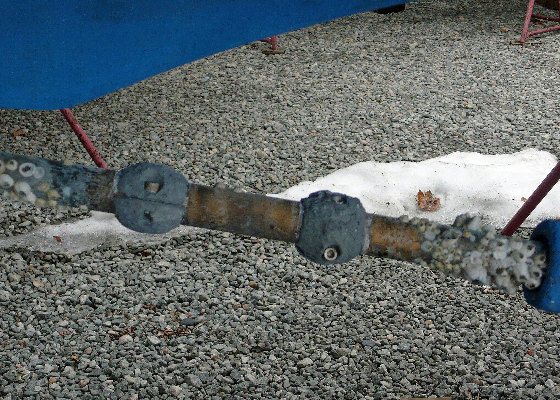
anodecount_8532.jpg
Rapid Anode Consumption, Bottom Paint Blistering and More! Yikes! This series of problems was brought to us from one of our readers last week. We need to share this one because there is a lot going on here, and power or sail, some of the tips here can help you along the way if some of these symptoms crop up.

Rapid Anode Consumption, Bottom Paint Blistering and More! Yikes!
This series of problems was brought to us from one of our readers last week. We need to share this one because there is a lot going on here, and power or sail, some of the tips here can help you along the way if some of these symptoms crop up. So here’s the note from our reader:
“Hi Ed, I am ABYC-Marine Electrical certified and was recently asked to look at an ’01 Sea Ray 28 w/ 2 Merc Alpha 1 Gen 2 stern drives in CT. Water is salt/brackish depending on the tide, anodes are all active aluminum and their mating surfaces are paint/oil free. Erosion of the anodes on both the drives and the trim tabs has been a tad excessive, 2 month replacement shows 75-90% wear.
The problems were: 1. Bottom paint was blistering around all metal thru hull fittings 2. Stern drives literally rotted off the boat galvanically after new owner failed to note the excessive anode wear 3. Batteries continuously “boil”, even when the converter is not on any source of AC power over the course of two days!
The steps taken: Drives/ transom assemblies replaced, Mercathode units were installed on both assemblies as well as the factory anodes. Hydro-Coat paint was stripped and repainted w/ a harder, non-ablative paint. All thru hull fittings were replaced with Marelon fittings, and the converter was replaced with a Xantrex programmable unit, set to the lead-acid charge curve. All batteries were replaced, lead-acid, non-PVR. Bonding throughout the boat was tested and in great shape. Galvanic Isolator tested ok and was installed at the factory correctly, but unit was replaced anyways. Again, problem seems to occur even when the boat is unplugged from shore power/ generator not running .
The hull problems seem to have vanished, and the silver/silver chloride test is nominal until the anodes get about 2 months of erosion on them; dead center in the range supplied by the manufacturer. However, the batteries keep “boiling”, by which I mean venting electrolyte all over the tops and eventually drying themselves right out if water isn’t added almost daily. Eventually the batteries won’t hold a charge, as the electrolyte has become diluted by constant refills by the owner. Ambient temperature seems to have no effect on the rate at which they “boil” off. Frustrating!
Could these problems be interrelated? It’s all DC which makes sense, but we have tested and/or replaced everything we know of. No other boats on the dock seem to have a problem, so unless they are ALL using this poor boat as a sacrificial anode, it doesn’t appear to be a dock related issue.
Any ideas? Thanks Ed, great blog!”
Wow, what a bad string of events. OK, so here is what we know about some of these problems. First, the blistering bottom paint. We have known this to be a problem for some time now, especially with bottom paints that have a cuprious oxide content that is over about 55%. We have also noted that this seems to occur more frequently with black colored anti-foulant. Two things seem to work to mitigate this problem. One is to strip the bottom paint off the metalix fittings and re-paint them with some epoxy barrier coat. Then re-apply anti-foulant. Another cure we have seen work is to back off on the sacrificial anode voltage potential for the cathodic protection system. Get it down to about a maximum of -650 mV when tested in saltwater with a silver chloride reference electrode. In this case, our reader replaced all the fittings with Marelon through-hulls. OK, that will work as well. It also reduces the amount of metal that needs protection with anodes. All good on that count.
As for the seemingly rapid anode consumption, I think that our reader needs to double check that the galvanic isolator is truly OK and able to block galvanic currents. Otherwise the boat’s anodes are indeed helping to protect all the boats on the same dock and will surely eat up any sacrifical anodes.
The battery issue is a mystery with the information provided. A new set of batteries and a new and programmable carger installed and they’re still boiling over? Demons, it is near Haloween after all. More info needed on this one.
Click here to read more about blistering bottom paint.
Photo Left







